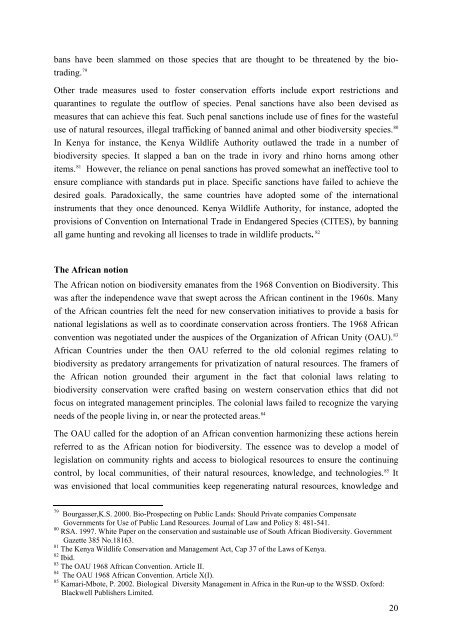THE UNIVERSITY OF LEIPZIG
THE UNIVERSITY OF LEIPZIG
THE UNIVERSITY OF LEIPZIG
You also want an ePaper? Increase the reach of your titles
YUMPU automatically turns print PDFs into web optimized ePapers that Google loves.
ans have been slammed on those species that are thought to be threatened by the bio-<br />
trading. 79<br />
Other trade measures used to foster conservation efforts include export restrictions and<br />
quarantines to regulate the outflow of species. Penal sanctions have also been devised as<br />
measures that can achieve this feat. Such penal sanctions include use of fines for the wasteful<br />
use of natural resources, illegal trafficking of banned animal and other biodiversity species. 80<br />
In Kenya for instance, the Kenya Wildlife Authority outlawed the trade in a number of<br />
biodiversity species. It slapped a ban on the trade in ivory and rhino horns among other<br />
items. 81 However, the reliance on penal sanctions has proved somewhat an ineffective tool to<br />
ensure compliance with standards put in place. Specific sanctions have failed to achieve the<br />
desired goals. Paradoxically, the same countries have adopted some of the international<br />
instruments that they once denounced. Kenya Wildlife Authority, for instance, adopted the<br />
provisions of Convention on International Trade in Endangered Species (CITES), by banning<br />
all game hunting and revoking all licenses to trade in wildlife products. 82<br />
The African notion<br />
The African notion on biodiversity emanates from the 1968 Convention on Biodiversity. This<br />
was after the independence wave that swept across the African continent in the 1960s. Many<br />
of the African countries felt the need for new conservation initiatives to provide a basis for<br />
national legislations as well as to coordinate conservation across frontiers. The 1968 African<br />
convention was negotiated under the auspices of the Organization of African Unity (OAU). 83<br />
African Countries under the then OAU referred to the old colonial regimes relating to<br />
biodiversity as predatory arrangements for privatization of natural resources. The framers of<br />
the African notion grounded their argument in the fact that colonial laws relating to<br />
biodiversity conservation were crafted basing on western conservation ethics that did not<br />
focus on integrated management principles. The colonial laws failed to recognize the varying<br />
needs of the people living in, or near the protected areas. 84<br />
The OAU called for the adoption of an African convention harmonizing these actions herein<br />
referred to as the African notion for biodiversity. The essence was to develop a model of<br />
legislation on community rights and access to biological resources to ensure the continuing<br />
control, by local communities, of their natural resources, knowledge, and technologies. 85 It<br />
was envisioned that local communities keep regenerating natural resources, knowledge and<br />
79 Bourgasser,K.S. 2000. Bio-Prospecting on Public Lands: Should Private companies Compensate<br />
Governments for Use of Public Land Resources. Journal of Law and Policy 8: 481-541.<br />
80 RSA. 1997. White Paper on the conservation and sustainable use of South African Biodiversity. Government<br />
Gazette 385 No.18163.<br />
81 The Kenya Wildlife Conservation and Management Act, Cap 37 of the Laws of Kenya.<br />
82 Ibid.<br />
83 The OAU 1968 African Convention. Article II.<br />
84 The OAU 1968 African Convention. Article X(I).<br />
85 Kamari-Mbote, P. 2002. Biological Diversity Management in Africa in the Run-up to the WSSD. Oxford:<br />
Blackwell Publishers Limited.<br />
20






